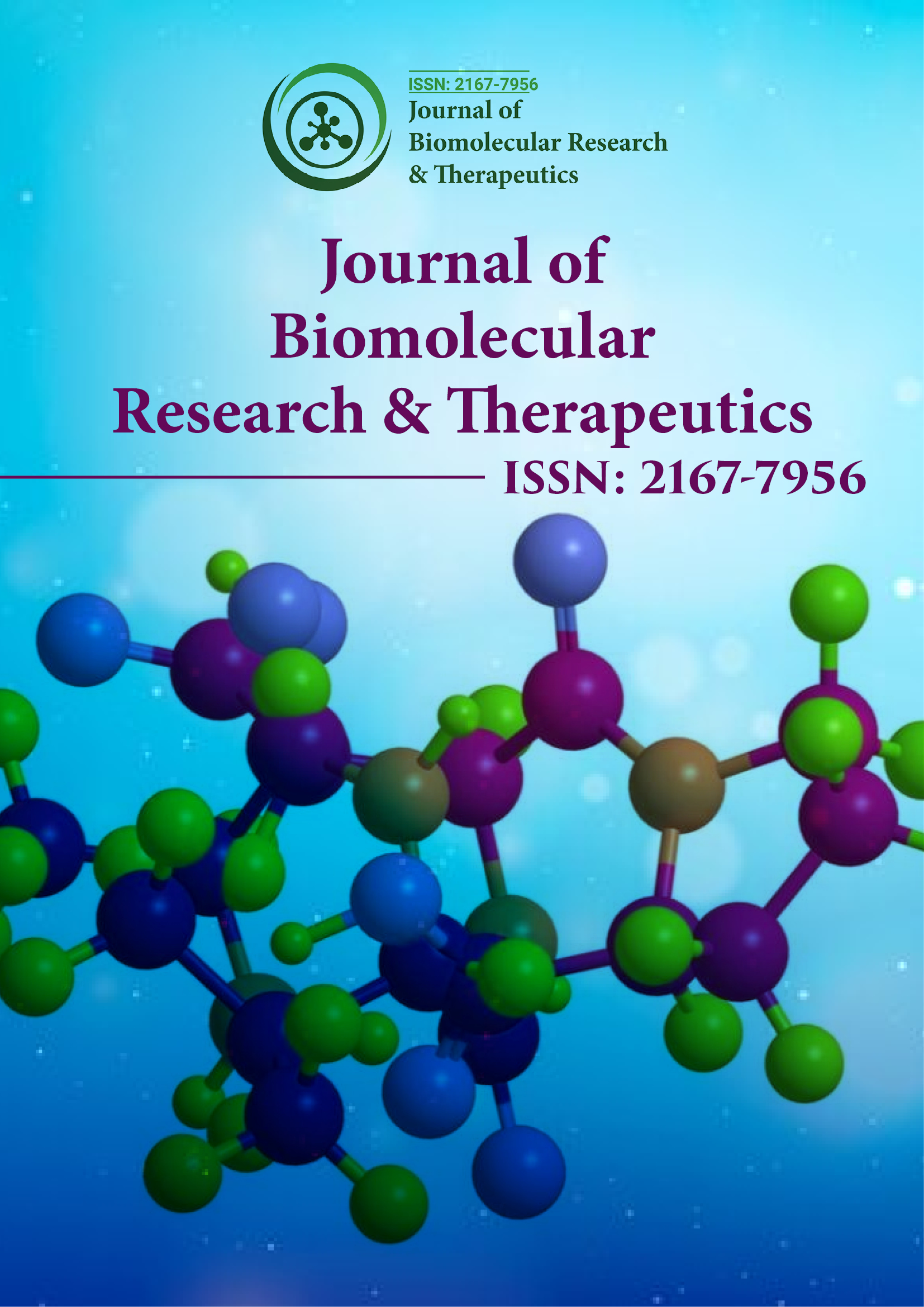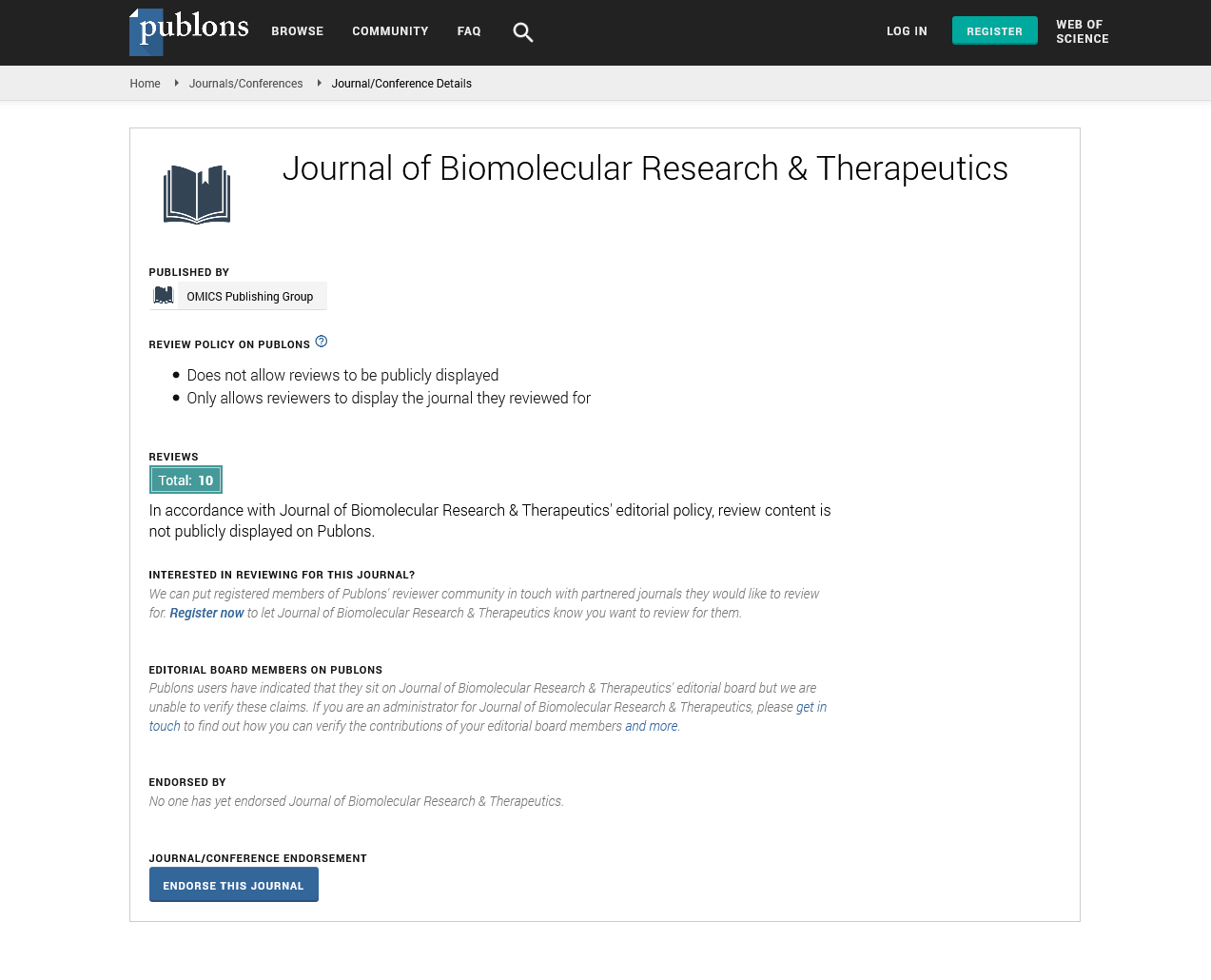Indexed In
- Open J Gate
- Genamics JournalSeek
- ResearchBible
- Electronic Journals Library
- RefSeek
- Hamdard University
- EBSCO A-Z
- OCLC- WorldCat
- SWB online catalog
- Virtual Library of Biology (vifabio)
- Publons
- Euro Pub
- Google Scholar
Useful Links
Share This Page
Journal Flyer

Open Access Journals
- Agri and Aquaculture
- Biochemistry
- Bioinformatics & Systems Biology
- Business & Management
- Chemistry
- Clinical Sciences
- Engineering
- Food & Nutrition
- General Science
- Genetics & Molecular Biology
- Immunology & Microbiology
- Medical Sciences
- Neuroscience & Psychology
- Nursing & Health Care
- Pharmaceutical Sciences
Short Communication - (2023) Volume 12, Issue 12
The Role of Biomolecules in Signal Transduction in Cellular Communication
Ellen Rubel*Received: 06-Nov-2023, Manuscript No. BOM-23-24339; Editor assigned: 08-Nov-2023, Pre QC No. BOM-23-24339(PQ); Reviewed: 30-Nov-2023, QC No. BOM-23-24339; Revised: 07-Dec-2023, Manuscript No. BOM-23-24339(R); Published: 14-Dec-2023, DOI: 10.35248/2167-7956.23.12.363
Description
Signal transduction is a fundamental process in biology that rules how cells perceive, interpret, and respond to signals from their environment. This complex mechanism involves the transmission of information from the extracellular environment to the intracellular setting, organizing a many of cellular responses. At the heart of signal transduction are biomolecules molecules vital for the transmission and execution of cellular signals. This article delves into the intricacies of signal transduction in biomolecules, unraveling the complex web of interactions that underlie cellular communication. Signal transduction can be broadly defined as the process by which cells convert extracellular signals into functional responses. These signals, often in the form of ligands, can originate from various sources, including neighboring cells, hormones, or the extracellular matrix. The cell surface serves as the primary interface for signal reception, where membrane receptors act as molecular switches that, upon activation, initiate a cascade of events leading to a cellular response.
The gatekeepers of signal transduction
Membrane receptors play a pivotal role in signal transduction by serving as the interface between the extracellular and intracellular environments. There are various types of membrane receptors, including G Protein-Coupled Receptors (GPCRs), Receptor Tyrosine Kinases (RTKs), and ion channel receptors. Each receptor type is specialized for different classes of ligands, and their activation triggers specific signaling pathways [1-5].
G Protein-Coupled Receptors (GPCRs): GPCRs constitute one of the largest and most diverse families of membrane receptors. They are involved in mediating signals for a wide range of stimuli, including light, odorants, neurotransmitters, and hormones. Upon ligand binding, GPCRs undergo conformational changes that activate intracellular G proteins, initiating downstream signaling cascades.
Receptor Tyrosine Kinases (RTKs): RTKs, as the name suggests, are membrane receptors with intrinsic kinase activity. Ligand binding induces receptor dimerization and auto phosphorylation of tyrosine residues, creating docking sites for downstream signaling molecules. These pathways often involve the activation of Ras and the Mitogen-Activated Protein Kinase (MAPK) cascade, regulating cell proliferation, differentiation, and survival.
Ion channel receptors: Ion channel receptors, primarily involved in the nervous system, undergo conformational changes upon ligand binding, allowing the passage of ions across the membrane. This alteration in ion flux is key for generating electrical signals, leading to neuronal communication.
Intracellular signaling pathways: Once the extracellular signal is received and transduced by membrane receptors, a series of intracellular events unfold to convey the message to the nucleus or other cellular compartments. These intracellular signaling pathways are diverse and often interconnected, forming complex networks that regulate various cellular processes.
Protein kinases and phosphatases: Phosphorylation is a ubiquitous mechanism in signal transduction, and protein kinases and phosphatases play central roles in this process. Kinases transfer phosphate groups to target proteins, while phosphatases remove them. The balance between kinase and phosphatase activities determines the cellular response.
Second messengers
Second messengers, such as cyclic AMP (cAMP), Inositol Triphosphate 3 (IP3), and Diacylglycerol (DAG), act as intermediaries in intracellular signaling. They amplify and propagate the signal initiated by membrane receptors, modulating the activity of downstream effectors.
Mitogen-Activated Protein Kinase (mapk) pathway: The MAPK pathway is a prototypical signaling cascade involved in cell proliferation, differentiation, and survival. Activation of RTKs or GPCRs triggers a series of phosphorylation events involving Ras, Raf, MEK, and ERK, ultimately influencing gene expression and cellular functions.
Nuclear Factor-Kappa b (nf-κb) pathway: The NF-κ Bpathway is vital in immune responses and inflammation. Activation of membrane receptors leads to the release of inhibitory proteins from NF-κB, allowing its translocation to the nucleus and the subsequent modulation of gene expression. Small GTPases, such as Ras, Rho, and Rab, act as molecular switches in signal transduction pathways. These proteins cycle between an active, GTP-bound state and an inactive, GDP-bound state, regulating various cellular processes, including cell proliferation, cytoskeletal dynamics, and vesicle trafficking [6-10].
Dysregulation of signal transduction in diseases
Aberrations in signal transduction pathways are implicated in various diseases, including cancer, neurodegenerative disorders, and autoimmune conditions. Mutations in receptors, downstream signaling molecules, or dysregulated feedback mechanisms can lead to uncontrolled cell growth, impaired immune responses, or neuronal dysfunction. Signal transduction in biomolecules is a captivating and complex dance that organizes cellular responses to environmental cues. From the initial reception of extracellular signals by membrane receptors to the modulation of gene expression in the nucleus, each step involves a many of biomolecules working in harmony. Unraveling the complexities of signal transduction not only enhances our basic understanding of cellular biology but also holds profound implications for the development of targeted therapeutics in various diseases. As research in this field continues to evolve, the journey into the world of biomolecular signaling promises to uncover new dimensions of cellular communication and regulation.
References
- Azadi P, Inderwildi OR, Farnood R, King DA. Liquid fuels, hydrogen and chemicals from lignin: A critical review. Renew. Sustain. Energy Rev. 2013; 21:506-523.
- Bang G. Energy security and climate change concerns: Triggers for energy policy change in the United States? Energy Pol. 2010;38(4):1645-1653
- Carpio LG, de Souza FS. Optimal allocation of sugarcane bagasse for producing bioelectricity and second generation ethanol in Brazil: Scenarios of cost reductions. Renew. Sustain. Energy. 2017; 111:771-780
- de Assis Castro RC, Fonseca BG, dos Santos HT, Ferreira IS, Mussatto SI, Roberto IC. Alkaline deacetylation as a strategy to improve sugars recovery and ethanol production from rice straw hemicellulose and cellulose. Ind. Crop. Prod. 2017; 106:65-73.
- Medina JD, Alomia FB, Magalhaes Jr AI, de Carvalho JC, Woiciechowsky AL, Soccol CR. Simulation of different biorefinery configuration including environmental, technical and economic assay using sugarcane bagasse. J. Clean. Prod. 2021; 316:128162
- de Moraes Dutenkefer R, de Oliveira Ribeiro C, Mutran VM, Rego EE. The insertion of biogas in the sugarcane mill product portfolio: A study using the robust optimization approach. Renew. Sustain. Energy Rev. 2018; 91:729-740.
- Dias MO, Cunha MP, Jesus CD, Rocha GJ, Pradella JG, Rossell CE, et.al Second generation ethanol in Brazil: can it compete with electricity production? Bioresour. Technol. 2011; 102(19):8964-71
[Crossref] [Google Scholar] [PubMed]
- Dias MO, Junqueira TL, Cavalett O, Cunha MP, Jesus CD, Rossell CE, et.al. Integrated versus stand-alone second generation ethanol production from sugarcane bagasse and trash. Bioresour. Technol. 2012; 103(1):152-161.
[Crossref] [Google Scholar] [PubMed]
- Alvira P, Tomás-Pejó E, Ballesteros M, Negro MJ. Pretreatment technologies for an efficient bioethanol production process based on enzymatic hydrolysis: a review. Bioresour. Technol. 2010; 101(13):4851-4861
[Crossref] [Google Scholar] [PubMed]
- Duval A, Lawoko M. A review on lignin-based polymeric, micro-and nano-structured materials. React. Funct. Polym. 2014; 85:78-96
Citation: Rubel E (2023) The Role of Biomolecules in Signal Transduction in Cellular Communication. J Biol Res Ther. 12:363.
Copyright: © 2023 Rubel. This is an open access article distributed under the terms of the Creative Commons Attribution License, which permits unrestricted use, distribution, and reproduction in any medium, provided the original author and source are credited.

